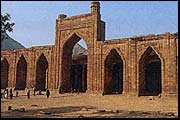 Adhai-din-ka-Jhonpra is one of the classic instances of religious vandalism, an outstanding example of an edifice built over the ruins of Jain temples. This famous mosque, situated on the border of Ajmer, is an inimitable example of primitive Indo-Islamic architecture. Constructed by Muhammad Ghori, Adhai- din-ka-Jhonpra has a slew of interesting legends to its name. While some believe that this mosque was built within a short span of two and half days and hence, the name, a few others associate the name to the two and half day fair that is held within the mosque premise every year. Previously, a seat of learning, this place was seized, demolished, and restored as a mosque by Ghori in the year 1198. Ghori constructed seven arched walls around the mosque and engraved it with calligraphic verses from the Holy Quran. Later, an attractive tower was added to the place. Today, this striking piece of architecture stands tall with its towering domes, pillars, and arched screens.
Adhai-din-ka-Jhonpra is one of the classic instances of religious vandalism, an outstanding example of an edifice built over the ruins of Jain temples. This famous mosque, situated on the border of Ajmer, is an inimitable example of primitive Indo-Islamic architecture. Constructed by Muhammad Ghori, Adhai- din-ka-Jhonpra has a slew of interesting legends to its name. While some believe that this mosque was built within a short span of two and half days and hence, the name, a few others associate the name to the two and half day fair that is held within the mosque premise every year. Previously, a seat of learning, this place was seized, demolished, and restored as a mosque by Ghori in the year 1198. Ghori constructed seven arched walls around the mosque and engraved it with calligraphic verses from the Holy Quran. Later, an attractive tower was added to the place. Today, this striking piece of architecture stands tall with its towering domes, pillars, and arched screens.Brief History
Formerly a Sanskrit college, this seat of learning was constructed by Seth Viramdeva Kala in 660 A.D. for the Panch Kalyan Mahotsava of the Tirthankaras. A magnificent building with sprawling courtyard, carved roofs, and striking pillars, this building was quick to catch the fancy of Muhammad Ghori soon after he annexed Ajmer in 1192 A.D. He was so pleased by the place that he ordered his men to knock down the edifice and build a mosque instead. Thus, the temple and the learning center were demolished and the mosque came into being. They placed seven cloisters carved with Islamic script on the western side and a mimbar and a mehrab near it to make it look like a mosque. A Sanskrit calligraphy on the top of the main entrance narrates the history of the place. This mosque includes 10 domes, which is supported by 124 pillars.
Major Attractions
Two of the biggest attractions of this mosque are its main hall embellished with carved pillars, and arches made of yellow limestone on the main front wall of the entrance. Apart from this, the mosque houses a tower that was used by the Muezzin to offer namaz. The walls of the prayer hall are beautifully carved with intriguing rectangular panels, much like the Persian mosques, which lend this place an aura of elegance.
Apart from visiting this place, you can also make a quick jaunt to other nearby shrines like Dargah Sharif, which is the tomb of Sufi Saint Khwaja Moinuddin Chisti. It is also one of the famous and holiest shrines for Muslims in India. The tomb is made of marble with a gold-plated dome. Another shrine is the Taragarh Fort, which houses the Dargah of Miran-Saheb. It is 3 kilometers away from Adhai-din-ka-Jhonpra.
The most favorable time to visit Ajmer is from October to March, when the weather is lovely and enjoyable. During the monsoons, i.e. from August to September, Ajmer looks breathtakingly beautiful with rain-washed Aravalli Range adding to the beauty of the city. One must avoid visiting Ajmer during the summers, as the singeing sun can scorch you down.
How To Reach
By Air:
The nearest airport to Ajmer is Jaipur, the capital of Rajasthan. From there, you can avail local cabs or private taxis that will take you to Ajmer.
By Train:
Ajmer is linked by train from all the major cities of India. The best option is to catch a train from Delhi. There are trains like Shatabdi Express, The Pink City Express and Chetak Express that will take you easily to Ajmer.
By Road:
Ajmer is well connected by a good network of roads from Delhi, Agra and other major cities of Rajasthan. So finding a public road transport won't be difficult.
Adhai-din-ka-Jhonpra is a sacred site for the Muslims. This mosque stands as a fine example of Indo-Islamic architecture. It relays the history of Mughal emperors and is one of the best places to visit in Ajmer because of its historical and spiritual relevance.


